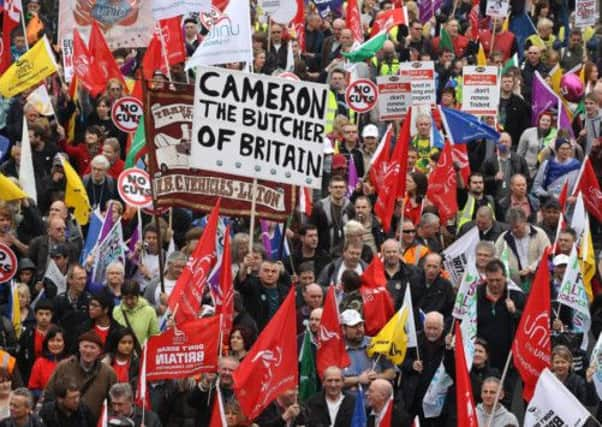Gregor Gall: ‘You won’t get me as part of the Union’


Time and again, Labour leaders relied upon the union block vote to outmanoeuvre the constituencies.
Just how much things have changed is revealed by the attitude of unions to the independence referendum. Labour is the prime mover in the Better Together No campaign which involves the Tories and the Liberal Democrats. Set up over a year ago, it has only just gained its first union affiliate, namely, the train drivers’ union, Aslef. With just under 20,000 members, Aslef’s affiliation is not going to set the heather on fire for the unionist camp.
Advertisement
Hide AdAdvertisement
Hide AdThis means that not only have all the big guns amongst the affiliated unions – Unite, Unison and the GMB especially – not declared their support for the Union, but it is unclear if they might ever. The creation of Labour’s own campaign for the Union – called United with Labour – does not seem to radically change this situation.
So, are unions not for the Union? Most are unwilling to work with the Tories and the Lib Dems, hence their body swerve of Better Together. But that does not to say they are automatically enamoured with United for Labour either.
The first reason is that under the leadership of Anas Sarwar, United with Labour is likely to follow the same type of policies that his boss, Johann Lamont, has set out for the Scottish Labour Party. Unions have noticed that while talking of attaining social justice is fine, it does not sit at all well with Lamont’s questioning of universal benefits and her infamous broadside against the supposed “something for nothing” society we live in.
More than anything else, they notice there is little in the way of a positive case for the Union. No pledges have been made to reverse the cuts made since 2010, nor see an end to the working poor and the like. In other words, unless (British) Labour is able to provide a radical, progressive agenda, the Union looks rather unappealing.
Second, there is the no small matter of what union members think. After the unheeded and fractious recommendation from the STUC to vote Labour in the 2007 Scottish Parliament elections, unions in Scotland are especially keen to make sure they reflect what their members’ views are. They know that many of their members voted SNP in 2011.
Put together, this means unions in Scotland have not been prepared to accept any instruction from their London-based headquarters to do Labour’s bidding. But this also means that with a split amongst their members across the spectrum of Yes, No and Don’t Know, there is a danger for them in taking any position.
Consequently, the STUC, along with Unite and Unison, is still at the stage of asking questions of both the Yes and No camps without any hint of which way they might fall (if at all). All three organisations could go a step further and say that if either side wanted their recommendation and support the price would be to sign up to a clear set of policies.
Meantime, the third largest union, the GMB, has decided to allow its Scottish members to have the say. Although critical of both camps, the GMB is more likely than Unite or Unison to back the Union.
Advertisement
Hide AdAdvertisement
Hide AdUnions like the shopworkers’ union, Usdaw, and the Community Union are also expected to back the Union (albeit on a less critical basis).
On the other side, the small membership of the Prison Officers’ Association has already backed independence. Its more positive experience of the SNP Holyrood governments – as opposed to Labour and coalition Westminster governments – has been a major factor.
The Scotland No 2 branch of the CWU communication workers union has firmly come out in support of independence and has helped establish Trade Unionists for Scottish Independence. But at this year’s CWU conference, the only support it could get for independence was from a branch in south-west England. However, the likelihood is that the Fire Brigades’ Union and the Public and Commercial Services (PCS) Union will back independence – albeit a more radical version than that on offer from the SNP.
The same is true for the RMT in Scotland. General secretary Bob Crow has expressed his support for independence and the national union will allow its branches to make their own minds up.
All this highlights three issues. One is that these unions see independence as offering the greater possibility of advancing a left-wing agenda – again one that the SNP is not offering – and the ability to escape from a continued age of austerity and neo-liberalism under the Westminster yoke. This will require the pro-independence Left to get its act together for the 2016 Scottish Parliament elections, though.
Another is that the end of the British Union does not mean the end of Britain-wide unions. There are no calls for the Scottish sections of unions to secede from their brothers and sisters south of the Border if Scotland becomes independent. Rather, it is anticipated that more autonomy for the Scottish sections of Britain-wide unions will do the trick quite nicely.
And, finally, these are non-Labour affiliated unions so have a bit more room for manoeuvre. With over 650,000 members in Scotland, the unions may become an important battleground for the Yes and No camps.
What will make this more interesting is the unions will not be passive, for as the referendum nears, they are likely to put conditions on the price for any support they give to either side.
• Gregor Gall is professor of industrial relations at the University of Bradford and lives in Edinburgh